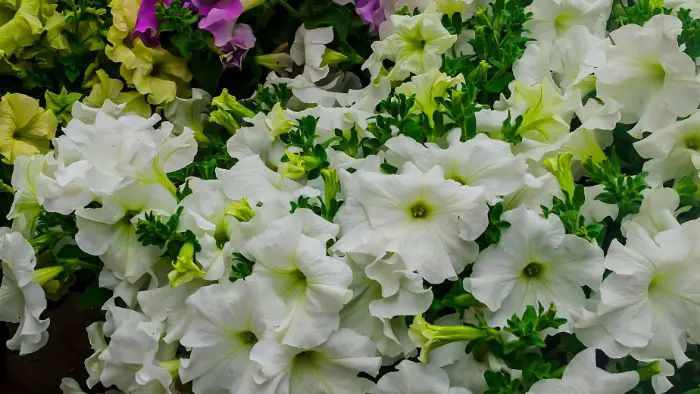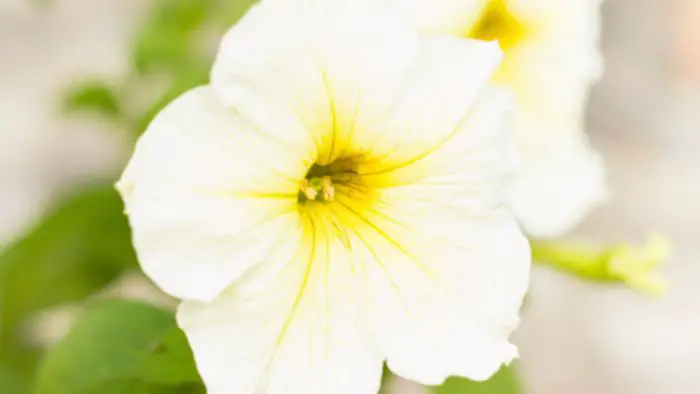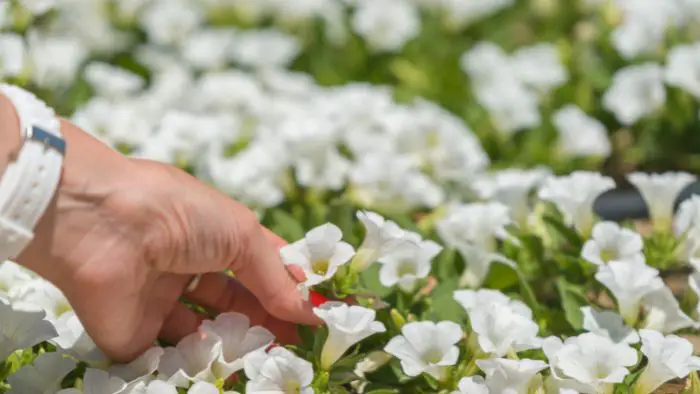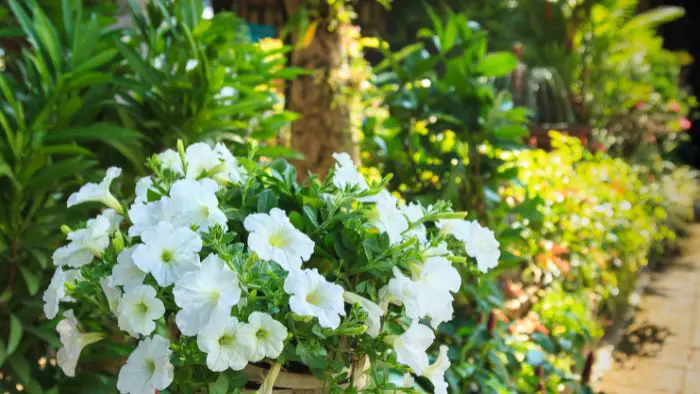Last Updated on December 13, 2022
White Wave Petunias are easy to grow and if afforded the right care and maintenance, you can look forward to outstanding results. They are consistent flowering plants that bloom throughout the season. These gorgeous plants are fast-growing with good uniformity and a good balance of mounding and spreading.
Petunias are sought-after plants as they are used to fill up planters, hanging baskets, and window boxes, and are great to enhance the look of your landscapes. Tolerating temperatures both hot and cold, the vines of these hardy plants grow over four feet long. Petunias grown in containers require regular fertilization and watering to maintain their stance.
Keep in mind that petunia seeds should not be started outside as they favor indoor temperatures. These plants also thrive in full sun with loose, rich, well-drained soil. For them to spread out and grow to their full potential, proper care and maintenance are required to get the best results. Learn more about the white wave petunias in the article below.
Do Wave Petunias Come In White?
Yes, wave petunias do come in white. The various types of these plants produce different colors that are a great asset to any indoor or outdoor garden. Wave petunias spread the most and can grow up to four feet across and six inches tall. This variety is available in pink, lilac, purple, red, and blue colors which are quite stunning.
Another lovely variety is the blue easy wave petunia, which also comes in white, shell pink, and red. They are simple to grow and work well as a cover for open garden spaces. These plants are heat resistant and add beauty to your garden while attracting hummingbirds.
White wave petunias have a unique trailing growth habit and are extremely prolific bloomers. They look great draped over the sides of containers and in raised beds in the summer season. The growth habit of a regular petunia is upright or bushy which is much different from the white wave variety.
How Do You Harvest Wave Petunia Seeds?
White-wave petunias blooms produce seeds in a seedpod which is located at the bottom of the flower. The seeds can be harvested when the plant is fully mature and fading. Additionally, you can also pinch the flowers to extend the bloom period. Alternatively, you can allow a few of them to die naturally to continue your seed harvesting endeavor.
Here are a few tips:
– When harvesting, ensure that you pinch the blooms at the base to remove them without damaging the plant.
-Thereafter, leave them out in a shallow tray to dry completely.
– After that, store the seeds in an airtight container for a few days.
– After this time you will see that the pods will split open, releasing the petunia seeds.
– The seeds can be stored in a cool, dry place if you’re not planting them immediately.
Note: Petunia seeds need a lot of light to grow because they are tiny. You should plant the seedlings about a foot apart when they have about three leaves. Use a container potting mix that will drain well if you’re planting in containers. Because petunias can withstand some heat, you shouldn’t have to worry about watering them frequently. Once a week, thorough watering should be enough unless there are prolonged periods of drought in your area. Remember to avoid shallow irrigation. This is because it will promote shallow roots.
Can You Save Seeds from Wave Petunias?
Yes, you can save seeds from white-wave petunias. To do this, you should begin by growing them in the appropriate conditions. This is because healthy petunia plants will produce blooms that are ideal for seed saving. You should also avoid soggy soils and excessive shade when growing these glorious bloomers.
This is because petunias prefer well-drained soil and direct sunlight. You can also pinch the flower tips back as they grow to encourage bushy growth. Below are a few ideas on how to save wave petunia seeds.
Seed Production
Near the end of the growing season, it is vital that you select healthy, disease-free petunias for seed production.
Natural seeds
To allow seed pods to form naturally, stop deadheading your petunia plant. Keep in mind that when the bloom fades and dies off, the seed pod begins to form.
Finding the seedpod
Keep an eye on the flower as it perishes and the petals naturally fall off. During this time, it is advisable to not remove it from the plant. The seedpod is encased in the calyx, a bulbous structure at the base of the flower.
Maturity
Check on the calyx daily as it swells with developing seeds at which time it will turn from green to brown. Also, keep an eye out for signs of cracking. When the seedpod begins to crack, cut it off the stem as this is an indication that the seeds have reached full maturity. Any soft or damp pods should be discarded because they will cause mold which will flaw the seeds.
Drying seeds
Allow the seeds to dry out completely. You can spread them out to dry on a tray. Be sure to leave plenty of space between them for air circulation. Store the pods in a cool, dry place away from direct sunlight for about a week.
Testing for dryness
To test if the pods are dry, take some between your fingers and squeeze them. You will know if the seeds are dry if it is difficult to break. To release the tiny seeds into the bowl, squish the pod. Remove any husk and debris.
Storage
Place the seeds in an envelope or small paper bag when storing them. These seeds can be stored for up to 5 years in a cool, dry place.
Do Wave Petunias Come Back Every Year?
Although petunias are perennial plants, they are commonly grown as annuals because of their growth pattern. These plants will often survive and even bloom during the winter months in year-round warm climates. However, if the temperature becomes too low, it can reduce the time of their flowering period. If you find your white wave petunia wilting, here are a few things you can do to avoid this and keep them thriving.
Climatizing Petunias
If you live in a colder climate and want your petunias to grow back in the spring, keep them indoors during the winter.
Proper watering
If your wave petunia is drying out, the first thing you should do is make sure you’re giving them enough water. This is because they require frequent watering when grown in containers or in the ground.
White Wave Petunia Care
Reviewing the care you’ve been giving your plant is essential. Although petunias are easy to grow, one unintentional oversight can have a negative impact on how well they thrive. Their primary requirement is plenty of sunlight as they prefer at least six hours of direct light per day.
Fertilizing
Establishing a regular fertilizing schedule should help you remember when it’s time to feed your petunias. You should fertilize once every three weeks for regular, in-ground petunias, once a week for spreading types, and once every two weeks for container plants. Over-fertilizing could lead to pest and disease problems so ensure that you follow the proper directions.
Here’s a video that shows you how to plant the perfect wave petunias in hanging baskets.
Conclusion
White wave Petunias are easy to grow and maintain. It poses no special challenges as long as this plant is given the proper care it requires. These plants are commonly grown for their delicate, colorful flowers, pleasant scent, and long blooming season. They make great bedding plants and are also widely grown in containers.
Although watering once a week in most conditions is recommended, a fine spray mist applied to soil and foliage is advised to avoid water-logging of the soil, which can damage the roots. However, keep in mind that this will also depend heavily on the climate in your region.
Remember not to over-fertilize your white wave petunias to aid them in staying disease free, healthy, and happy. If you notice the plant leaves changing to a brown or yellow color, take heed because these are clear signs of over-fertilization. Overall, petunias are a great addition to any surrounding. Not only are they eye-catching, but they’re also great for very simple to grow and harvest. For information about growing petunias, here’s an informative link.
Sharon Vanessa hails from the sunny side of Southern Africa. She is an avid gardener with a great interest in indigenous plants from around the globe. Aside from gardening, Sharon is also a full-time writer who has a concentration on non-fiction content. With her experience in script writing, she hopes to eventually produce an independent film or theatre production in the near future. Family means everything to Sharon; therefore, she spends her free time with the people who make life worth living. Her other hobbies include cooking, baking, and exploring the incredible wildlife in South Africa.




